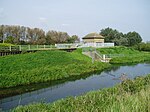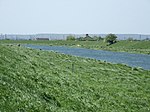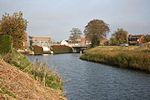Counter Drain railway station

Counter Drain railway station was a remote station in Lincolnshire serving the village of Tongue End. It was on the route of the Spalding and Bourne Railway (opened 1866), later part of the Midland and Great Northern Joint Railway which ran across East Anglia to the Norfolk Coast. The station opened with the line on 1 August 1866, closed temporarily between 9 October 1880 and 1 February 1881, and closed permanently on 2 March 1959, although the line remained open for goods until 1964. The three intermediate stations between Spalding and Bourne had unusual names, because there were few nearby settlements; "Counter Drain" was the name of a drainage ditch close to the station.
Excerpt from the Wikipedia article Counter Drain railway station (License: CC BY-SA 3.0, Authors, Images).Counter Drain railway station
Counter Drain Drove, South Holland Deeping St. Nicholas
Geographical coordinates (GPS) Address Nearby Places Show on map
Geographical coordinates (GPS)
| Latitude | Longitude |
|---|---|
| N 52.7725 ° | E -0.255 ° |
Address
Counter Drain Drove
Counter Drain Drove
PE11 3JL South Holland, Deeping St. Nicholas
England, United Kingdom
Open on Google Maps










